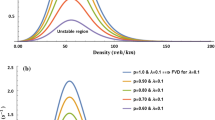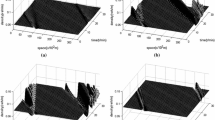Abstract
Considering the backward looking effect, a modified continuum model is put forward. The stability criterion of this continuum model is deduced by performing linear stability analysis. The theoretical result demonstrates that the traffic flow is stabilized considering backward looking effect. The KdV-Burgers equation is obtained through perturbed nonlinear analysis, which could show the propagating process of density wave. Numerical simulation is carried out to explores how backward looking affected each car’s velocity, density and energy consumption. Numerical results demonstrate that backward looking effect has significant impact on traffic dynamic characteristic. In addition, the energy consumptions of this modified continuum model are also studied. Numerical simulation results indicate that the effect of backward looking will suppress the traffic jam and decrease cars’ energy consumptions during the whole evolution of small perturbation.








Similar content being viewed by others
References
Tang, T.Q., Zhang, J., Liu, K.: A speed guidance model accounting for the driver’s bounded rationality at a signalized intersection. Phys. A 473, 45–52 (2017)
Tang, T.Q., Huang, H.J., Shang, H.Y.: An extended macro traffic flow model accounting for the driver’ s bounded rationality and numerical tests. Phys. A 468, 322–333 (2017)
Tang, T.Q., Luo, X.F., Liu, K.: Impacts of the driver’s bounded rationality on the traffic running cost under the car-following model. Phys. A 457, 316–321 (2016)
Tang, T.Q., Yu, Q.: Influences of vehicles’ fuel consumption and exhaust emissions on the trip cost without late arrival under car-following model. Int. J. Mod. Phys. C 27, 1650011 (2016)
Li, Y.F., Sun, D.H., Liu, W.N., Zhang, M., Zhao, M., Liao, X.Y., Tang, L.: Modeling and simulation for microscopic traffic flow based on multiple headway, velocity and acceleration difference. Nonlinear Dyn. 66, 15–28 (2011)
Bando, M., Hasebe, K., Shibata, A., Sugiyama, Y.: Dynamical model of traffic congestion and numerical simulation. Phys. Rev. E 51, 1035–1042 (1995)
Lighthill, M.J., Whitham, G.B.: On kinematic waves. I. Flood movement in long rivers. Proc. R. Soc Lond. Ser. A 229, 281–316 (1955)
Lighthill, M.J., Whitham, G.B.: On kinematic waves. II. A theory of traffic flow on long crowded roads. Proc. R. Soc. Lond. Ser. A 229, 317–345 (1955)
Richards, P.I.: Shock waves on the highway. Oper. Res. 4, 42–51 (1956)
Payne, H.J.: Mathematical models of public systems. Simul. Counc. Proc. Ser. 1, 51–61 (1971)
Jiang, R., Wu, Q.S., Zhu, Z.J.: Full velocity difference model for a car-following theory. Phys. Rev. E 64, 017101 (2001)
Jiang, R., Hu, M.B., Zhang, H.M., Gao, Z.Y., Jia, B., Wu, Q.S., Wang, B., Yang, M.: Traffic experiment reveals the nature of car-following. PLOs ONE 9, 4 (2014)
Jiang, R., Hu, M.B., Zhang, H.M., Gao, Z.Y., Jia, B., Wu, Q.S.: On some experimental features of car-following behavior and how to model them. Transp. Res. B 80, 338–354 (2015)
Tang, T.Q., Wu, Y.H., Caccetta, L., Huang, H.J.: A new car-following model with consideration of roadside memorial. Phys. Lett. A 375, 3845–3850 (2011)
Tang, T.Q., Wang, Y.P., Yang, X.B., Wu, Y.G.: A new car-following model accounting for varying road condition. Nonlinear Dyn. 70, 1397–1405 (2012)
Tang, T.Q., Shi, W.F., Shang, H.Y., Wang, Y.P.: A new car-following model with consideration of inter-vehicle communication. Nonlinear Dyn. 76, 2013–2017 (2014)
Zhu, W.X., Zhang, L.D.: Analysis of car-following model with cascade compensation strategy. Phys. A 449, 265–274 (2016)
Peng, G.H., Cheng, G.H.: A new car-following model with the consideration of anticipation optimal velocity. Phys. A 392, 3563–3569 (2013)
Peng, G.H., Lu, W.Z., He, H.D., Gu, Z.H.: Nonlinear analysis of a new car-following model accounting for the optimal velocity changes with memory. Commun. Nonlinear Sci. Numer. Simul. 40, 197–205 (2016)
Song, H., Ge, H.X., Chen, F.Z., Cheng, R.J.: TDGL and mKdV equations for car-following model considering traffic jerk and velocity difference. Nonlinear Dyn. 87, 1809–1817 (2017)
Nagatani, T.: Thermodynamic theory for the jamming transition in traffic flow. Phys. Rev. E 58, 4271–4276 (1998)
Nagatani, T.: TDGL and MKDV equation for jamming transition in the lattice models of traffic. Phys. A 264, 581–592 (1999)
Nagatani, T.: Jamming transition in the lattice models of traffic. Phys. Rev. E 59, 4857–4864 (1999)
Li, Z.P., Liu, F.Q., Sun, J.: A lattice traffic model with consideration of preceding mixture traffic information. Chin. Phys. B 20, 088901 (2011)
Ge, H.X., Cheng, R.J., Lo, S.M.: Time-dependent Ginzburg Landau equation for lattice hydrodynamic model describing pedestrian flow. Chin. Phys. B 22, 070507 (2013)
Sun, D.H., Zhang, M., Chuan, T.: Multiple optimal current difference effect in the lattice traffic flow model. Mod. Phys. Lett. B 28, 1450091 (2014)
Sun, D.H., Zhang, G., Liu, W.N.: Effect of explicit lane changing in traffic lattice hydrodynamic model with interruption. Nonlinear Dyn. 86, 269–282 (2016)
Li, Z.P., Zhong, C.J., Chen, L.Z., Xu, S.Z., Qian, Y.Q.: Analytical studies on a new lattice hydrodynamic traffic flow model with consideration of traffic current cooperation among three consecutive sites. Int. J. Mod. Phys. C 27, 1650034 (2016)
Peng, G.H., Qing, L.: The effects of drivers aggressive characteristics on traffic stability from a new car-following model. Mod. Phys. Lett. B 30, 1650243 (2016)
Li, X.Q., Fang, K.L., Peng, G.H.: A new lattice model of traffic flow with the consideration of the drivers’ aggressive characteristics. Phys. A 468, 315–321 (2017)
Nagatani, T.: Modified KdV equation for jamming transition in the continuum models of traffic. Phys. A 261, 599–607 (1998)
Ge, H.X., Lai, L.L., Zheng, P.J., Cheng, R.J.: The KdV-Burgers equation in a new continuum model with consideration of driver’s forecast effect and numerical tests. Phys. A 377, 3193–3198 (2013)
Lai, L.L., Cheng, R.J., Li, Z.P., Ge, H.X.: Theoretical analysis of the density wave in a new continuum model and numerical simulation. Phys. A 402, 0378–4371 (2014)
Liu, F.X., Cheng, R.J., Zheng, P.J., Ge, H.X.: TDGL and mKdV equations for car-following model considering traffic jerk. Nonlinear Dyn. 261, 793–800 (2015)
Liu, H.Q., Zheng, P.J., Zhu, K.Q., Ge, H.X.: KdV-Burgers equation in the modified continuum model considering anticipation effect. Phys. A 438, 26–31 (2015)
Liu, H.Q., Cheng, R.J., Zhu, K.Q., Ge, H.X.: The study for continuum model considering traffic jerk effect. Nonlinear Dyn. 83, 57–64 (2016)
Cheng, R.J., Ge, H.X., Wang, J.F.: An extended continuum model accounting for the driver’s timid and aggressive attributions. Phys. A 381, 1302–1312 (2017)
Nakayama, A., Sugiyama, Y., Hasebe, K.: Effect of looking at the car that follows in an optimal velocity model of traffic flow. Phys. Rev. E 65, 016112 (2001)
Ge, H.X., Zhu, H.B., Dai, S.Q.: Effect of looking backward on traffic flow in a cooperative driving car following model. Eur. Phys. J. B 54, 503–507 (2006)
Ge, H.X., Cheng, R.J.: The “backward looking” effect in the lattice hydrodynamic model. Phys. A 387, 6952–6958 (2008)
Sun, D.H., Liao, X.Y., Peng, G.H.: Effect of looking backward on traffic flow in an extended multiple car-following model. Phys. A 390, 631–635 (2011)
Yang, D., Jin, P., Pu, Y., Ran, B.: Safe distance car-following model including backward-looking and its stability analysis. Phys. B 86, 92 (2013)
Jiang, R., Wu, Q.S., Zhu, Z.J.: A new continuum model for traffic flow and numerical tests. Transp. Res. B 36, 405–419 (2002)
Berg, B., Woods, A.: Traveling waves in an optimal velocity model of freeway traffic. Phys. Rev. E 64, 035602 (2001)
Arqub, O.A.: Numerical solutions for the Robin time-fractional partial differential equations of heat and fluid flows based on the reproducing kernel algorithm. J. Numer. Methods Heat Fluid Flow Int. (2017). https://doi.org/10.1108/HFF-07-2016-0278
Arqub, O.A.: Fitted reproducing kernel Hilbert space method for the solutions of some certain classes of time-fractional partial differential equations subject to initial and Neumann boundary conditions. Comput. Math. Appl. 73, 1243–1261 (2017)
Arqub, O.A., El-Ajou, A., Momani, S.: Constructing and predicting solitary pattern solutions for nonlinear time-fractional dispersive partial differential equations. J. Comput. Phys. 293, 385–399 (2015)
El-Ajou, A., Arqub, O.A., Momani, S.: Approximate analytical solution of the nonlinear fractional KdV-Burgers equation: a new iterative algorithm. J. Comput. Phys. 293, 81–95 (2015)
Herrmann, M., Kerner, B.S.: Local cluster effect in different traffic flow models. Phys. A 255, 163–188 (1998)
Kerner, B.S., Konhauser, P.: Cluster effect in initially homogeneous traffic flow. Phys. Rev. E 48, 2335–2338 (1993)
Acknowledgements
This work is supported by the National Natural Science Foundation of China (Grant Nos. 11702153, 71571107, 61773290), the Natural Science Foundation of Zhejiang Province, China (Grant No. LY18A010003) and the K.C. Wong Magna Fund in Ningbo University, China. Funding was provided by National Natural Science Foundation of China (Grant No. 11372166), the Scientific Research Fund of Zhejiang Provincial, China (Grant Nos. LY15A020007, LY15E080013).
Author information
Authors and Affiliations
Corresponding author
Ethics declarations
Conflict of Interests
The authors declare that there is no conflict of interests regarding the publication of this article.
Rights and permissions
About this article
Cite this article
Liu, Z., Wang, J., Ge, H. et al. KdV-Burgers equation in the modified continuum model considering the “backward looking” effect. Nonlinear Dyn 91, 2007–2017 (2018). https://doi.org/10.1007/s11071-017-3999-7
Received:
Accepted:
Published:
Issue Date:
DOI: https://doi.org/10.1007/s11071-017-3999-7




